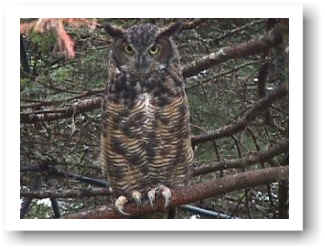
Great Horned Owl
Bubo virginianus virginianus
Status
Native to both Newfoundland and Labrador.
Habitat
Great Horned Owls prefer densely forested areas, both deciduous and coniferous, and more open woodlands, especially marshes adjacent to woodlands, parks, rivers or anywhere prey is plentiful. They prefer dense evergreen forest during roosting.
Range
Found in all forested and semi-forested areas of Canada.
Food
Great Horned Owls have a varying diet, preferring medium-sized mammals and birds, such as hares, grouse, duck and small mammals such as mice and voles.
The Great Horned Owl swallows small prey whole but later regurgitates the fur, teeth, bones and feathers which it cannot digest, in the form of “pellets.”
Predators/Threats
This owl has few natural enemies but may be killed or injured when attacking larger prey. Nestlings are sometimes taken by hawks or other predators. Human disturbance also accounts for injuries and deaths from accidents with power lines or from illegal shooting by farmers or hunters. Fifty percent of young great horned owls die within their first year.
Lifespan
Great Horned Owls can live for thirteen years in the wild, and have been known to live more than twenty years in captivity.
Appearance
Plumage is usually brown to grey-brown in color and is heavy and soft. However, color varies according to geographical location (eg. dark in Labrador and British Columbia and lighter in the Northwest Territories and northern Prairie Provinces). The Great Horned Owl is second in size only to the Snowy Owl; it has prominent ear tufts or “horns”, hence its name. It’s large, yellow eyes, broad face, and curved beak and claws are also distinctive.
Breeding Biology
Pairs mate for life, with most breeding at 2 years of age. The female will lay anywhere from 1-5 eggs (average of two), depending on the availability of food. Incubation is completely by the female; however, both male and female will defend the nest.
Average Weight/Measurements
Average weight is (3 lbs)(1.5 kg); average length is (2 ft)(55.4 cm).
Notes:
- Great Horned Owls are early nesters. The eggs are laid and incubation occurs while snow is still on the ground.
- Special flight feathers allow the owl to descend silently on its prey undetected.
- The Great Horned Owl has the largest eyes of all North American owls.
- It can lift and carry prey much heavier than itself (eg. a 3 lb. owl can carry 8-9 lb. prey.
- The common “hooting” owl often heard at dusk and at night. It has a deep, resonating hoot, usually in a series of five (hoo, hoo hoo, hoo, hoo).
- Often called “cat owl” in Newfoundland because of facial resemblance to a lynx or house cat.
At Salmonier Nature Park
- The Great Horned Owl is the most common owl species occurring in the wild in Salmonier Nature Park, and nests have been recorded nearby.
- Our two display birds, one of which has a wing injury and one which was hand-raised from birth, are unreleasable.
- Because male and female Great Horned Owls are so similar in color and appearance, it is difficult to determine the sex.
